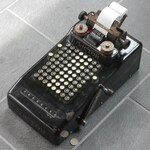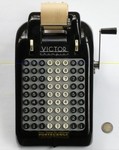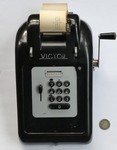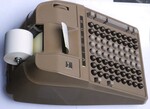



Victor 2 adding machine
Video
Victor 6-8-0 adding machine
Victor 7-8-0 adding machine
Video
Victor 16-83-54 adding machine
Video
History
Models
Paraphernalia
Advertisements
Articles
Patents
Links
This is a Victor series 2 adding machine, the first printing adding machines that VIctor produced. These were retrospectively called the model 210.
It has a full keyboard with 8 columns of keys. At the front of the machine is a register behind a glass window that shows the current total. To add a number, enter it on the keyboard and pull the large lever on the right. This prints the number and adds it to the register. To print a total or subtotal, hold down the Total button as you pull the lever towards you. If you release the button before returning the lever, the register contents remain unaffected (i.e. a subtotal), but if you keep the Total button pressed when you return the lever then the register is reset to zero. Totals and subtotals are printed in red, and are marked with the letter T. If you enter a number and hold down the Non-Add button when pulling the lever, then the number is printed in black, marked with the letter N, without being added to the register. Finally, there is a Repeat button that can be locked down to avoid the input being cleared from the keyboard.
This machine has serial number 28112, which dates this machine to about 1922. These early machines still have keys with metal-rimmed keytops, instead of the later plastic ones.
Here is a video where I demonstrate the Victor 2 adding machine.
This adding listing machine by Victor is designated Champion, but the underlying model type is probably 6-8-0. The first digit means it is part of the 6-line of machines, the middle digit says it has an 8-digit input (9-digit register), and the final digit means it is manual rather than electric.
This adding machine has a full keyboard. If you enter a number on the keyboard and pull the crank that is on the right hand side of the machine, then the number gets printed and is added to the running total that is stored internally. After adding several numbers you can print the total by flicking the button next to the crank using your thumb just as you begin to pull the crank. That button can be moved in two directions - away from you for a subtotal (the register remains unaffected), towards you for a total (the register is cleared). Note that moving this button without using the crank has the effect of clearing the input from the keyboard. There is also a button on the left of the machine which disables the automatic clearing of the input so that you can do repeated additions of the same number.
This model does not do subtraction, but there are other, more expensive models in the 6-line that do.
The machine has serial number 770,461 which dates it to about 1950. The case can be very easily removed. Pull off the crank, and move the two catches on the underside of the machine, and then the case can be lifted off. This has been made so easy to allow access to the ink ribbon.
This is the Victor model 7-8-0. It is in many ways identical to the Victor 6 above, except that it has a 10-key keyboard. Above the keypad is a small window with a pointer that indicates how many digits you have entered so far. On the left is a slider that will clear the entered input.
It has serial number 622,080 which dates it to about 1948. It shares many parts with the 6-line above. There are subtle differences too, which are presumably due to continuous minor improvements. For example, the handle of the crank is made of wood but two years later they were made from plastic.
Here is a video where I demonstrate the Victor series 6 and 7 adding machines.
This adding listing machine by Victor is the model 16-83-54. The first number 16 indicates that it is a successor of the model 6, so it uses a full keyboard for inputting numbers. The 8 in the middle number means that it has an 8-digit input ( and 9-digit internal register), and the 5 in the last number means it is an electrically driven machine. I do not know the exact meaning of the other digits.
It is very simple to use. After entering a number, pressing the plus or minus button will print the number and add or subtract it from the register. The keyboard is automatically cleared for the next addition or subtraction, unless the R button has been pushed in. The keyboard can be cleared manually (e.g. to correct an error) by pressing the C button. To print a sub-total, press the S button. Pressing the T button prints the total, and clears the internal register. The N button prints the entered number without affecting the value of the register.
The machine was in production between 1960 and 1967, and the serial number of 2541-358 suggests it was one of the later ones. The case can be very easily removed - slide back two catches on the underside of the machine, remove the spindle of the paper roll, and then the case can be lifted off. This has been made so easy to allow access to the ink ribbon.
Here is a video where I demonstrate the Victor 16-83-54.
The Victor Adding Machine Company was founded in Chicago on 8th March 1918 by Oliver D. Johantgen, George S. Eldred and O.E. Cheesman. Johantgen was the main engineer. They had little experience in running a business, and the company would have failed if it were not for the investment and knowledge of Carl Buehler, owner of a chain of meat markets and grocery stores. Buehler was voted president of the company a few months later.
The first Victor adding machine was non-printing, and was put on the market in 1919. Two years later the Victor series 2 was released which was an adding-listing machine. The machine was cheaper than most equivalent competitor machines, and hence became popular with smaller businesses. The biggest order for the adding machines was by the McCaskey Register Company who turned them into cash registers.
In 1924 the series 3 appeared, which from 1928 was able to do subtraction directly. Victor also attracted Max Garbell to develop a typewriter, but this was not successful enough so was discontinued when the great depression hit. The series 5 adding machine from 1932 had optional electric drive, but also was a tough sell because the depression caused many second-hand Victor machines to appear on the market. Johantgen unexpectedly died in 1932, so eventually Thomas O. Mehan who had worked for Remington Rand was hired to be the new chief engineer. For Victor he designed the series 6 and 7, which were put on the market in about 1939.
During the second world war Victor manufactured various machinery for the military, most notably the Norden bomb sight that was also used by the bombers that released the atom bombs on Hiroshima and Nagasaki.
In the 1950s Victor hired the retired Oscar Sundstrand to improve on Mehan's designs, and he turned them into full four-function calculators that could do automatic multiplication and division.
In 1961 the Victor Adding Machine Company and Comptometer Corporation (formerly Felt and Tarrant) merged to become the Victor Comptometer Corporation. It stopped producing comptometers, but did import the Bell Punch Sumlock 993 which were rebranded as Comptometers. It seems that Victor was especially interested in the Electrowriter that Comptometer Corp was developing, which was an early kind of fax machine. It is notable that Victor also made electric vehicles, for industry and for use as golf carts, and this very successful sideline probably grew out of their wartime manufacturing efforts.
Victor managed to transition to electronic calculators, data automation, and computers. During the 1980s the calculator division went through several changes of ownership, but today still exists as Victor Technology LLC.
The following table lists the first several series of Victor machines:
The model numbering then started to get very confusing as many further variants and successors of the series 6 and 7 were developed. There were for example series 60, 61, 16, and 67, with the corresponding 10-key equivalent series 70, 71, 17, and 77. Eventually the full keyboard variants were no longer viable, so further series only appeared with a 10-key keyboard. Some were released with the label Diplomat, Champion, Custom or Premier. The later series with multiplication and division were called the Divi-matic or Multo-matic. However, by 1973 the mechanical machines were obsolete and production ceased as cheap electronic calculators became available.
The following table shows the serial numbers at the start of each year of production. The table was constructed by combining several tables found online elsewhere.
|
|
Printing blocks
1932-1940?
These are three printing blocks used for printing advertisements. One depicts a Victor series 5, one a series 6 with advertising text, and the third a series 7.
Victor Product and Price Manual (PDF, 37.1 MB or archive.org)
1940-1961
118mm × 185mm × 17mm
This is a small ring binder containing information for the Victor
salesperson. It has a sections on the available adding machine
models, their additional features and accessories, and price lists.
Especially interesting are the lists of trade-in prices of other
calculators, for some of which there are tables of serial numbers.
The copyright year varies from 1940 to 1961, as some pages in the
binder have been replaced by updated versions. Pages 3 to 8 are
missing, and I presume they contained an introductory message from
the Victor company director that the original owner deemed unnecessary.
Victor Ink Ribbon
1961+
50mm × 50mm × 20mm
This is an ink ribbon in its original box. It dates from after 1961, since the company name on the box is the Victor Comptometer Corporation.
Here are some articles that I found in online archives of newspapers and magazines. There is a separate page for the many Advertisements from those archives.
| Patent | Filing date | Publish date | Name | Description |
|---|---|---|---|---|
| US 1,301,941 | 29-05-1916 | 29-04-1919 | Oliver D. Johantgen | 10-key adding listing machine |
| US 1,301,942 | 29-05-1916 | 29-04-1919 | Oliver D. Johantgen | Carry mechanism |
| US 1,301,943 | 29-05-1916 | 29-04-1919 | Oliver D. Johantgen | Register |
| US 1,306,112 | 16-05-1917 | 10-06-1919 | Oliver D. Johantgen; Victor Adding Machine Company | Adding machine (Victor 1) |
| US 1,336,840 | 04-01-1918 | 13-04-1920 | Oliver D. Johantgen; Victor Adding Machine Company | Listing machine (Victor 2) |
| US 1,378,119 | 04-01-1918 | 17-05-1921 | Oliver D. Johantgen; Victor Adding Machine Company | Rack-bar and bearing |
| US 1,396,215 | 04-01-1918 | 08-11-1921 | Oliver D. Johantgen; Victor Adding Machine Company | Clear-signal printing |
| US 1,569,188 | 02-04-1925 | 12-01-1926 | Oliver D. Johantgen; Victor Adding Machine Company | Adding machine |
| US 1,580,492 | 25-09-1922 | 13-04-1926 | Oliver D. Johantgen; Victor Adding Machine Company | Non-add and Total key mechanism |
| US 1,757,669 | 25-09-1922 | 06-05-1930 | Oliver D. Johantgen; Victor Adding Machine Company | Flexible handle connection |
| US 1,788,916 | 25-09-1922 | 13-01-1931 | Oliver D. Johantgen; Victor Adding Machine Company | Non-add printing mechanism |
| US 1,810,213 | 05-07-1927 | 16-06-1931 | Oliver D. Johantgen; Victor Adding Machine Company | Improved subtraction mechanism |
| US 1,816,014 | 27-04-1925 | 28-07-1931 | Oliver D. Johantgen; Victor Adding Machine Company | Extra register |
| US 1,876,056 | 23-09-1929 | 06-09-1932 | Oliver D. Johantgen; Victor Adding Machine Company | Paper feeding mechanism |
| US 1,876,057 | 23-09-1929 | 06-09-1932 | Oliver D. Johantgen; Victor Adding Machine Company | Item counting mechanism |
| US 2,091,728 | 24-08-1936 | 31-08-1937 | Harold W. Clark; The McCaskey Register Company | Key release |
| US 2,098,486 | 02-03-1936 | 09-11-1937 | Harold W. Clark; The McCaskey Register Company | Cash register with two drawers |
| US 2,160,539 | 13-07-1936 | 30-05-1939 | Harold W. Clark; The McCaskey Register Company | Paper equipment for cash registers |
| US 2,264,949 | 05-01-1940 | 02-12-1941 | Thomas O. Mehan; Victor Adding Machine Company | Motor drive |
| US 2,270,460 | 05-01-1940 | 20-01-1942 | Thomas O. Mehan; Victor Adding Machine Company | Governor mechanism |
| US 2,274,919 | 22-09-1938 | 03-03-1942 | Harold W. Clark; The McCaskey Register Company | Code printing on cash register |
| US 2,276,464 | 03-08-1939 | 17-03-1942 | Harold W. Clark; The McCaskey Register Company | Split keyboard. See also: CA 397,820 |
| US 2,277,498 | 17-06-1937 | 24-03-1942 | Thomas O. Mehan; Victor Adding Machine Company | Adding machine |
| US 2,281,851 | 01-02-1937 | 05-05-1942 | Thomas O. Mehan; Victor Adding Machine Company | Printing mechanism |
| US 2,318,000 | 14-03-1941 | 04-05-1943 | Erhard M. Lippert; Victor Adding Machine Company | Platen mechanism |
| US 2,329,129 | 25-05-1939 | 07-09-1943 | Thomas O. Mehan; Victor Adding Machine Company | Ribbon mechanism |
| US 2,346,265 | 30-12-1940 | 11-04-1944 | Thomas O. Mehan; Victor Adding Machine Company | Zero printing and column split mechanism |
| US 2,352,279 | 25-05-1939 | 27-06-1944 | Thomas O. Mehan; Victor Adding Machine Company | Detachable paper spool mounting |
| US 2,360,005 | 30-12-1940 | 10-10-1944 | Thomas O. Mehan; Victor Adding Machine Company | Key set control mechanism |
| US 2,362,709 | 21-11-1941 | 14-11-1944 | Thomas O. Mehan; Victor Adding Machine Company | Calculating machine |
| US 2,377,707 | 01-10-1940 | 05-06-1945 | Thomas O. Mehan; Victor Adding Machine Company | Control switch |
| US 2,378,858 | 11-06-1943 | 19-06-1945 | Thomas O. Mehan; Victor Adding Machine Company | Gyro-vertical |
| US 2,379,449 | 31-07-1941 | 03-07-1945 | Thomas O. Mehan; Hunter E. Hooe; Victor Adding Machine Company | Multiplying machine |
| US 2,384,761 | 10-11-1943 | 11-09-1945 | Thomas O. Mehan; Victor Adding Machine Company | Gyro-vertical |
| US 2,396,188 | 06-03-1942 | 05-03-1946 | Thomas O. Mehan; Hunter E. Hooe; Victor Adding Machine Company | Calculating machine |
| US 2,411,050 | 23-12-1940 | 12-11-1946 | Thomas O. Mehan; Victor Adding Machine Company | Calculating machine |
| US 2,429,522 | 06-03-1942 | 21-10-1947 | Thomas O. Mehan; Hunter E. Hooe; Victor Adding Machine Company | Transfer mechanism |
| US 2,475,510 | 04-07-1939 | 05-07-1949 | Thomas O. Mehan; Victor Adding Machine Company | Total-taking control |
| US 2,486,959 | 15-01-1940 | 01-11-1949 | Thomas O. Mehan; Victor Adding Machine Company | Calculating machine |
| US 2,497,784 | 15-05-1944 | 14-02-1950 | Thomas O. Mehan; Hunter E. Hooe; Victor Adding Machine Company | Remote control mechanism |
| US 2,550,581 | 22-04-1948 | 24-04-1951 | Thomas O. Mehan; Victor Adding Machine Company | Credit balance mechanism |
| US 2,568,350 | 14-03-1946 | 18-09-1951 | Thomas O. Mehan; Victor Adding Machine Company | Control means for differential actuators |
| US 2,635,812 | 15-07-1946 | 21-04-1953 | Thomas O. Mehan; Victor Adding Machine Company | Transfer mechanism |
| US 2,824,688 | 17-08-1954 | 25-02-1958 | Thomas O. Mehan; Victor Adding Machine Company | Ten key actuator stop mechanism |
| US 2,834,542 | 14-01-1954 | 13-05-1958 | Oscar J. Sundstrand; Victor Adding Machine Company | Totalizer engaging mechanism |
| US 2,860,575 | 28-03-1956 | 18-11-1958 | William E. Sievers; Victor Adding Machine Company | Tag and ticket printing machine |
| US 2,984,412 | 03-02-1956 | 16-05-1961 | Oscar J. Sundstrand; Victor Adding Machine Company | Printing calculating machine |
| US 3,024,975 | 14-01-1954 | 13-03-1962 | Oscar J. Sundstrand; Victor Adding Machine Company | Multiplication and division control mechanism |
| US 3,030,010 | 14-01-1954 | 17-04-1962 | Oscar J. Sundstrand; Victor Adding Machine Company | Printing calculating machine |
© Copyright 2021-2025 Jaap Scherphuis, mechcalc a t jaapsch d o t net.